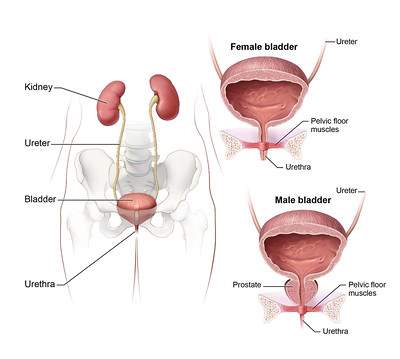Urinary system
- Draw and label different parts of the nephron.
- Enumerate the functions of the kidney, body fluid compartment, and distal tubules.
- Differentiate between glomerular capillary and peritubular capillary.
- State the mechanism of autoregulation of renal blood flow.
- What is GFR with normal value? Name the factor influencing GFR.
- What is the filtration fraction?
- Why glomerular capillary is more permeable than other capillaries?
- Describe the basic mechanism of Na2 transport from the tubular lumen into the blood.
- State the sodium reabsorption from the thick segment of the loop of Henley and proximal convoluted tubule and distal convoluted tubule.
- Outline the mechanism of reabsorption of HCO3- from the renal tubule.
- Discuss the mechanism of reabsorption of water at different parts of the renal tubule.
- Name the basic process of urine formation.
- What is the counter-current mechanism? How is hyperosmolarity of renal medullary interstitium produced?
- State the mechanism of secretion of ammonia.
- Discuss the mechanism of acidification of urine.
- Define diuresis, and differentiate between water and osmotic diuresis.
- Name the component of the counter-current mechanism to write down the factors that are responsible for hyperosmotic renal medullary interstation.
- Name the hormones acting on the kidney.
- What do you mean by plasma clearance and osmotic clearance?
- What is water clearance?
- What is the atonic and automatic bladder? Cortical nephron.
- Short notes on:
- Diuresis
- Juxtaglomerular complex
- Cortical nephron
- Anion gap
- M.G
- Insensible perspiration.
- Osmotic clearance
- Water clearance
- Difference between cortical and juxtamedullary nephron.
- Give a 24-hour water intake and output chart to an adult.
- Define and calculate net filtration pressure.
- If the renal plasma flow is 650 ml/min. how can you calculate renal blood flow?
- Draw and label the glomerular membrane.
- Whey protein cannot pass through the glomerular membrane.
- Why was insulin used to measure GFR? Give clearance value of urea, PAH, and creatinine.
- Name the processes involved in the secretion of H+ into renal tubules. Show with a diagram the role of the kidney in acid-base balance. What is limiting PH?
- How does alkaline glomerular filtrate become acidic urine?
- Renal function test.
- Secretion of aldosterone.
- Substances that reabsorbed in PCT. How sodium reabsorption occurs from the tubules.
- Explain how is glucose reabsorbed from the PT of the kidney.
- What is the tubular load?
- What is the JG complex?
- Enumerate the function of proximal tubules of kidneys.
- State the tubular glomerular feedback mechanism for controlling GFR.
- Name the factors that determine the concentrated urine.
- Why is the loop of Henley called the countercurrent mechanism?
- Name the layers of the adrenal cortex with their secretion.
- Write down the function and regulation of the secretion of aldosterone.
- Innervate the homeostatic function of the kidney.
Alimentary system
- Name the local hormones of GIT. Source and function of any three of them.
- Site of secretion and function of cholecystokinin.
- Daily secretion, PH of a. Sliva b. gastric juice c. pancreatic juice
- Name the most constituents of gastric juice. With the source and function of any 4.
- Name the composition of bile.
- Define saliva and write functions.
- Different phases of gastric juice secretion.
- Short notes on
- Alkaline tide
- Postprandial alkaline tide
- Enterohepatic circulation
- Bile
- Migratory motor complex
- Micelles
- Peristalsis
9. What is the metabolic and hydrolytic type of secretion? Write their differences.
10. How pancreatic juice secretion is regulated?
- Why the autodigestion of the pancreas not occur?
- What is bile? Justify bile as a digestive juice. Name the digestive juice.
- The function of bile salt. How bile secretion is regulated?
- Name the bile salt with function.
- Name the bile acid.
- How bile is formed?
- Name the liver function test.
- Name the digestive enzymes.
- List the enzymes of the pancreas.
- List the glands in the stomach with their functions.
- What do you mean by digestion and absorption?
- Digestion and absorption of cholesterol, are important dietary cholesterol.
- How does bile help in fat digestion and absorption?
- Name the movements of GIT. Briefly discuss segmentation. Give the mechanism and purpose of any of them.
- Stages of swallowing.
- The function of the stomach.
- Factors that regulate stomach emptying, and its affecting factors.
- What is the law of the gut?
- Describe the digestion of a piece of meat.
- The function of the liver.
- List the enzymes' concern with carbohydrate digestion along with the site of action in the alimentary tract. How glucose is absorbed from GIT?
- Name the digestive enzyme present in pancreatic juice.
- How is gastric secretion regulated?
- Name the proteolytic enzyme of pancreatic juice.
- Name the gastrointestinal hormones. Write about the regulation of the secretion and function of any two of them.
Also Read: Biochemistry Notes
Physiology notes

Comments (0)